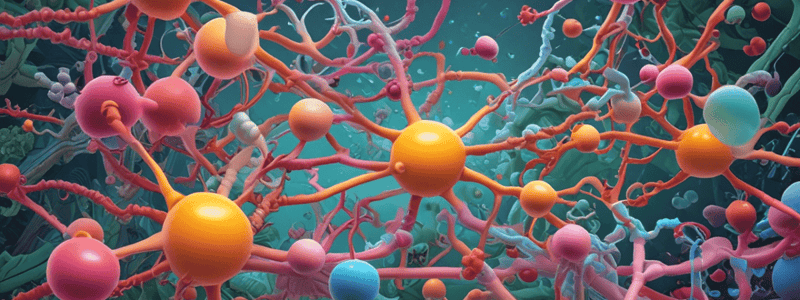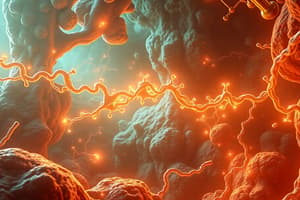Podcast
Questions and Answers
What is the main function of the Electron Transport Chain (ETC)?
What is the main function of the Electron Transport Chain (ETC)?
- Produce metabolic water by combining electrons with O2 and H+. (correct)
- Store excess energy in the form of NADH and FADH2.
- Facilitate the breakdown of lipids and nucleotides.
- Support cellular defense mechanisms via NADPH production.
Why are compounds that inhibit the proteins complexes of the ETC considered lethal?
Why are compounds that inhibit the proteins complexes of the ETC considered lethal?
- They stimulate the production of excess NADPH, disrupting cellular defense mechanisms.
- They disrupt the electron transfer process, leading to cell death. (correct)
- They prevent the production of ATP in mitochondria.
- They cause an uncontrolled breakdown of lipids and nucleotides.
What is the role of CoQ in the Electron Transport Chain?
What is the role of CoQ in the Electron Transport Chain?
- Act as a proton pump in the mitochondria.
- Assist in the breakdown of lipids and nucleotides.
- Transport electrons between NADH and FADH2. (correct)
- Generate NADPH for cellular defense mechanisms.
How is ATP produced in mitochondria through the ETC?
How is ATP produced in mitochondria through the ETC?
What happens during oxidation in the ETC?
What happens during oxidation in the ETC?
Which part of the ETC creates an electrochemical gradient by pumping H+ ions?
Which part of the ETC creates an electrochemical gradient by pumping H+ ions?
What happens during reduction in the ETC?
What happens during reduction in the ETC?
How does the ETC use free energy released by electrons?
How does the ETC use free energy released by electrons?
What is the primary function of the Pentose Phosphate Pathway (PPP) in the cell?
What is the primary function of the Pentose Phosphate Pathway (PPP) in the cell?
Which of the following tissues has the highest activity of the Pentose Phosphate Pathway (PPP)?
Which of the following tissues has the highest activity of the Pentose Phosphate Pathway (PPP)?
Which of the following physiological processes is NOT directly dependent on NADPH?
Which of the following physiological processes is NOT directly dependent on NADPH?
What is the primary function of NADPH in the synthesis of nitric oxide (NO)?
What is the primary function of NADPH in the synthesis of nitric oxide (NO)?
How does NADPH contribute to the maintenance of cellular redox homeostasis?
How does NADPH contribute to the maintenance of cellular redox homeostasis?
Which of the following is NOT a major function of NADPH in physiological processes?
Which of the following is NOT a major function of NADPH in physiological processes?
What is the primary reason for the high activity of the Pentose Phosphate Pathway (PPP) in the lactating mammary gland?
What is the primary reason for the high activity of the Pentose Phosphate Pathway (PPP) in the lactating mammary gland?
What is the effect of uncouplers on the relationship between oxidation and phosphorylation?
What is the effect of uncouplers on the relationship between oxidation and phosphorylation?
What is the role of NADPH in cellular defense mechanisms?
What is the role of NADPH in cellular defense mechanisms?
Which of the following is a function of the Pentose Phosphate Pathway (PPP)?
Which of the following is a function of the Pentose Phosphate Pathway (PPP)?
What is the primary function of NADPH in physiological processes?
What is the primary function of NADPH in physiological processes?
Which of the following is a potential function of the respiratory burst in immune cells?
Which of the following is a potential function of the respiratory burst in immune cells?
How does the action of uncouplers differ from the action of respiratory inhibitors?
How does the action of uncouplers differ from the action of respiratory inhibitors?
What is the main function of the Cori Cycle?
What is the main function of the Cori Cycle?
What is the primary storage organ for glycogen in the body?
What is the primary storage organ for glycogen in the body?
Which enzyme is responsible for starting the glycogen chain during glycogenesis?
Which enzyme is responsible for starting the glycogen chain during glycogenesis?
What is the alternate name for the Pentose Phosphate Pathway (PPP)?
What is the alternate name for the Pentose Phosphate Pathway (PPP)?
Which hormone stimulates glycogenolysis and inhibits glycogenesis?
Which hormone stimulates glycogenolysis and inhibits glycogenesis?
What is the main source of substrate for gluconeogenesis?
What is the main source of substrate for gluconeogenesis?
Which enzyme elongates the glycogen chain during glycogenesis?
Which enzyme elongates the glycogen chain during glycogenesis?
What is the primary location of gluconeogenesis in the body?
What is the primary location of gluconeogenesis in the body?
Which of the following substrates is NOT used in gluconeogenesis?
Which of the following substrates is NOT used in gluconeogenesis?
Why is gluconeogenesis not considered the reverse of glycolysis?
Why is gluconeogenesis not considered the reverse of glycolysis?
Which of the following hormones stimulates gluconeogenesis?
Which of the following hormones stimulates gluconeogenesis?
What is the primary function of the TCA cycle in the context of gluconeogenesis?
What is the primary function of the TCA cycle in the context of gluconeogenesis?
Which of the following molecules is NOT a substrate for gluconeogenesis?
Which of the following molecules is NOT a substrate for gluconeogenesis?
What is the primary purpose of gluconeogenesis in the body?
What is the primary purpose of gluconeogenesis in the body?
Which of the following amino acids is NOT considered a glucogenic amino acid?
Which of the following amino acids is NOT considered a glucogenic amino acid?
What is the primary effect of UNCOUPLERS on cellular respiration?
What is the primary effect of UNCOUPLERS on cellular respiration?
Which of the following substances inhibits Complex IV in the electron transport chain?
Which of the following substances inhibits Complex IV in the electron transport chain?
How do UNCOUPLERS affect the relationship between oxidation and phosphorylation?
How do UNCOUPLERS affect the relationship between oxidation and phosphorylation?
Where does gluconeogenesis primarily occur in the body?
Where does gluconeogenesis primarily occur in the body?
What is the main function of ATP synthase in oxidative phosphorylation?
What is the main function of ATP synthase in oxidative phosphorylation?
Which of the following is an inhibitor of Complex I in the electron transport chain?
Which of the following is an inhibitor of Complex I in the electron transport chain?
What is the purpose of generating heat without ATP production in cells?
What is the purpose of generating heat without ATP production in cells?
What primarily regulates OXPHOS based on the energy needs of the cell?
What primarily regulates OXPHOS based on the energy needs of the cell?
Which hormone stimulates gluconeogenesis and inhibits insulin in the context of glucose metabolism?
Which hormone stimulates gluconeogenesis and inhibits insulin in the context of glucose metabolism?
What is the primary substrate used for gluconeogenesis from TAG breakdown?
What is the primary substrate used for gluconeogenesis from TAG breakdown?
Which compound is responsible for creating an electrochemical gradient during OXPHOS?
Which compound is responsible for creating an electrochemical gradient during OXPHOS?
What is the primary role of ATP synthase in cellular respiration?
What is the primary role of ATP synthase in cellular respiration?
Which amino acid is NOT considered a substrate for gluconeogenesis?
Which amino acid is NOT considered a substrate for gluconeogenesis?
Which of the following compounds is known to uncouple electron transport from ATP synthesis in mitochondria?
Which of the following compounds is known to uncouple electron transport from ATP synthesis in mitochondria?
What inhibits gluconeogenesis during glucose metabolism?
What inhibits gluconeogenesis during glucose metabolism?
What is the main function of ATP synthase in the context of oxidative phosphorylation?
What is the main function of ATP synthase in the context of oxidative phosphorylation?
Which pathway provides an important source of substrate for gluconeogenesis?
Which pathway provides an important source of substrate for gluconeogenesis?
What is the primary reason for the high activity of the Pentose Phosphate Pathway (PPP) in certain metabolic processes?
What is the primary reason for the high activity of the Pentose Phosphate Pathway (PPP) in certain metabolic processes?
Which of the following is NOT considered an inhibitor of Oxidative Phosphorylation?
Which of the following is NOT considered an inhibitor of Oxidative Phosphorylation?
How do uncouplers affect the relationship between electron transport and ATP synthesis in mitochondria?
How do uncouplers affect the relationship between electron transport and ATP synthesis in mitochondria?
Which enzyme is responsible for initiating the glycogen chain during glycogenesis?
Which enzyme is responsible for initiating the glycogen chain during glycogenesis?
'Glucose 6-phosphate' as a substrate in Glucose metabolism is primarily associated with which pathway?
'Glucose 6-phosphate' as a substrate in Glucose metabolism is primarily associated with which pathway?
What is the primary function of ATP synthase in the Electron Transport Chain (ETC)?
What is the primary function of ATP synthase in the Electron Transport Chain (ETC)?
Which of the following is a primary function of the Pentose Phosphate Pathway (PPP) in the cell?
Which of the following is a primary function of the Pentose Phosphate Pathway (PPP) in the cell?
What is the primary role of gluconeogenesis in the body?
What is the primary role of gluconeogenesis in the body?
How do uncouplers differ from respiratory inhibitors in their effects on the Electron Transport Chain (ETC)?
How do uncouplers differ from respiratory inhibitors in their effects on the Electron Transport Chain (ETC)?
Which part of the Electron Transport Chain (ETC) is responsible for pumping H+ ions across the inner mitochondrial membrane to create an electrochemical gradient?
Which part of the Electron Transport Chain (ETC) is responsible for pumping H+ ions across the inner mitochondrial membrane to create an electrochemical gradient?
How does the Electron Transport Chain (ETC) use the free energy released by the transfer of electrons?
How does the Electron Transport Chain (ETC) use the free energy released by the transfer of electrons?
Why are compounds that inhibit the protein complexes of the Electron Transport Chain (ETC) considered lethal?
Why are compounds that inhibit the protein complexes of the Electron Transport Chain (ETC) considered lethal?
What is the primary function of the Pentose Phosphate Pathway (PPP) in the cell?
What is the primary function of the Pentose Phosphate Pathway (PPP) in the cell?
Which of the following tissues has the highest activity of the Pentose Phosphate Pathway (PPP)?
Which of the following tissues has the highest activity of the Pentose Phosphate Pathway (PPP)?
What is the primary role of NADPH in the respiratory burst process?
What is the primary role of NADPH in the respiratory burst process?
Which of the following is NOT a substrate for gluconeogenesis?
Which of the following is NOT a substrate for gluconeogenesis?
What is the primary function of ATP synthase?
What is the primary function of ATP synthase?
How does the action of uncouplers differ from the action of respiratory inhibitors?
How does the action of uncouplers differ from the action of respiratory inhibitors?
What is the primary regulation point of the TCA cycle?
What is the primary regulation point of the TCA cycle?
Flashcards are hidden until you start studying
Study Notes
Electron Transport Chain (Respiratory Chain)
- Passes electrons from NADH and FADH2 to protein complexes and mobile electron carriers (CoQ and cytochrome C)
- Electrons ultimately combine with O2 and H+ to form H2O (metabolic water)
- Requires O2, making it the major consumer of oxygen in mammalian cells
- 4 transmembrane enzymatic complexes + 2 mobile electron carriers (CoQ, cytochrome C)
- Electron-transporting groups contain iron, sulfur, copper
- All are proteins except for CoQ
- Free energy released by electrons is used to pump H+
- Electrons are transferred from electron donor to electron receptor
- Oxidation → electrons are removed, Reduction → electrons are gained
- Phosphorylation of ADP to ATP:
- Pumps H+ from matrix across inner mitochondrial membrane at complexes I, III, and IV
- Creates an electrochemical gradient
- Energy created moves ATP synthase
- Generates NADPH for reductive biosynthesis of lipids (fatty acids, cholesterol, and steroids)
- Provides ribose residues for nucleotide and nucleic acid biosynthesis (ATP, NAD+, FAD, RNA, and DNA)
The Pentose Phosphate Pathway (PPP)
- Occurs in cell cytosol, no ATP is consumed or generated
- High activity in:
- Liver and adipose tissue: biosynthesis of fatty acids from acetyl-CoA
- Endocrine tissues: synthesis of cholesterol and steroid hormones
- Lactating mammary gland: production of milk fats and proteins
- Mature erythrocyte, lens and cornea: glutathione production (oxidative damage protection)
NADP+/NADPH
- Important source of electrons (reducing/oxidizing agent)
- Contributes to maintenance of cellular redox homeostasis
- Reduces cytochrome P450 (drug metabolism in liver)
- Synthesizes Nitric Oxide (NO) for smooth muscle relaxation, neurotransmission, and bactericidal activity
- Involved in lipogenesis, synthesis of steroids and fatty acids
- Participates in respiratory burst in phagocytic cells (NADPH-oxidase)
Glycogen Metabolism
- Glycogenesis: stores glucose as glycogen
- Main stores in liver (up to 10% of liver weight) and skeletal muscle (up to 1% of muscle weight)
- Glycogenolysis: glycogen mobilization from glycogen stores
- Occurs when blood glucose levels are low (i.e., fasting)
- Glycogen synthesis occurs in cell cytosol, each molecule contains around 60,000 glucose residues and is highly hydrophilic
- Important enzymes for synthesis: glycogenin (primer), glycogen synthase (elongate chain), and branching enzyme
- Glycogen storage diseases are associated with enzyme deficiencies
- Prolonged use of steroids can cause glycogen storage abnormalities
- Regulation: insulin (anabolic) stimulates glycogenesis and inhibits glycogenolysis, while glucagon (and epinephrine) (catabolic) stimulates glycogenolysis and inhibits glycogenesis
Cori Cycle and Gluconeogenesis
- Cori cycle: lactate produced by anaerobic glycolysis is transported to the liver and converted to glucose (gluconeogenesis pathway)
- Prevents lactic acidosis during anaerobic conditions in muscle
- Important source of substrate for gluconeogenesis
- Gluconeogenesis: production of glucose from non-sugar molecules
- Supplies plasma glucose needs between meals and during prolonged fasting
- Continuous process in carnivores and ruminants
- Hormone-controlled (stimulated by glucagon and epinephrine, inhibited by insulin)
- Substrates: lactate, pyruvate, glycerol, and glucogenic amino acids (e.g., alanine, arginine, aspartate)
ATP Synthase and Oxidative Phosphorylation Inhibitors and Uncouplers
- ATP synthase: multi-subunit enzyme that rotates to synthesize ATP from ADP and Pi
- Oxidative phosphorylation inhibitors:
- Complex I: barbiturate, insecticide (rotenone)
- Complex II: malonate, carboxin, and TTFA (Fe-chelating agent)
- Complex III: dimercaprol, antimycin
- Complex IV: hydrogen sulfide (H2S), carbon monoxide (CO), and cyanide
- Uncouplers dissociate oxidation from phosphorylation, generating heat instead of ATP
Studying That Suits You
Use AI to generate personalized quizzes and flashcards to suit your learning preferences.




